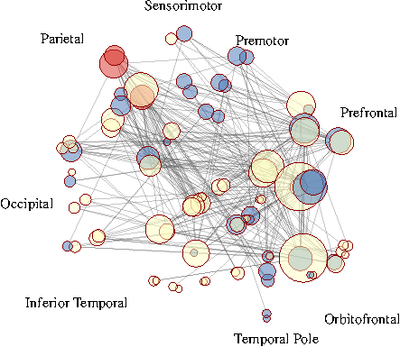Statistical Parametric Networks (SPNs): A Principled Way of Constructing Functional and Anatomical Networks.
Cedric Ginestet (King's College London), Andrew Simmons (King's College London), Ed Bullmore (University of Cambridge), Thomas E. Nichols (Warwick University)
A statistically principled way of conducting weighted network analysis is still lacking. In this paper, we describe two recent methodological advances in this field, related to (i) the construction of 'summary' networks representing variability in connectivity among several populations of networks (Ginestet and Simmons, 2011), and (ii) a mathematical framework for comparing the topology of weighted networks that vary in their number of edges.
Firstly, we adopt a mass univariate approach to construct statistical parametric networks (SPNs) that reflect significant modifications in functional connectivity in a canonical working memory task: the N-back paradigm. Our proposed method allows the extraction of `lost' and `gained' functional networks, providing concise graphical summaries of whole-brain network topological changes. Robust estimates of functional networks are obtained by pooling information about edges and vertices over subjects. Therefore, graph thresholding is here supplanted by inference. The analysis proceeds by firstly considering changes in weighted cost (i.e.~ mean between-region correlation) over the different N-back conditions and secondly comparing small-world topological measures integrated over network cost, thereby controlling for differences in mean correlation between conditions. In particular, we show that weighted cost considerably decreased as working memory load increased. Moreover, subject-specific weighted costs was also found to significantly predict behavioral performances on the N-back task, and therefore conferred predictive validity to functional connectivity strength, as measured by weighted cost.
Secondly, we tackle the issue of brain network topological comparison from a formal mathematical perspective. Comparison of different populations of weighted networks is hard because topology is inherently dependent on wiring cost, where cost is defined as the number of edges in an unweighted graph. We evaluate different approaches to the comparison of weighted networks that differ in mean association weight. In our key result, we prove that iStatistical Parametric Networks (SPNs): A Principled Way of Constructing Functional and Anatomical Networks.ntegrating over cost is equivalent to controlling for any monotonic transformationStatistical Parametric Networks (SPNs): A Principled Way of Constructing Functional and Anatomical Networks. of the weight set of a weighted graph. That is, when integrating over cost, we eliminate the differences in topology that may be due to a monotonic transformation of the weight set. This proposition holds for any unweighted topological measure. Cost-integration is therefore helpful in disentangling differences in cost from differences in topology. By contrast, we show that the use of the weighted version of a topological metric does not constitute a valid approach to this problem. Indeed, we prove that, under mild conditions, the use of the weighted version of global efficiency is equivalent to simply comparing weighted costs. Thus, we recommend the reporting of (i) differences in weighted costs and (ii) differences in cost-integrated topological measures.
All of these methods have been made publicly available through an R package entitled NetworkAnalysis, and some of the computational problems associated with handling large brain networks will also be discussed.
Ginestet, C.E. and Simmons, A. (2011). Statistical parametric network analysis of functional connectivity dynamics during a working memory task. NeuroImage, 5(2), 688-704.


 Latest news for Neuroinformatics 2011
Latest news for Neuroinformatics 2011 Follow INCF on Twitter
Follow INCF on Twitter
